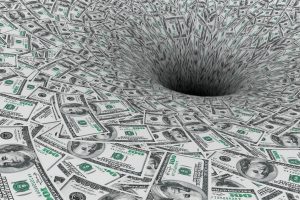Free Webinar for Litigators and Mediators: June 23: Using Decision Tree Analysis To Value Lawsuits and Negotiate Settlements
May 20, 2021Misuse of Probability in Decision Tree Analysis: Avoiding Garbage In, Garbage Out
July 15, 2021
At our June 23, 2021 webinar on decision tree analysis, we examined how to calculate the expected value (EV) of a lawsuit using a decision tree in connection with a mediation or settlement negotiations. We also discussed that once an EV is calculated, plaintiffs should subtract from EV the anticipated future costs of continuing to litigate (e.g., attorney and expert fees), while defendants should add anticipated future costs to the EV. We noted, however, that past, or sunk costs are irrelevant. Several attendees inquired into the basis for distinguishing between past and future costs. Let’s look at some hypotheticals.
Assume that during mediation of a commercial litigation, the mediator reaches a consensus with the parties on the structure of a decision tree showing the remaining material uncertainties to be resolved at trial with respect to liability and damages. Of course, both sides will almost certainly disagree concerning the probabilities of how these uncertainties will resolve.
Let’s say that using the agreed upon decision tree, the plaintiff concludes that the EV of the lawsuit is approximately $2M if the case were to go to trial. The plaintiff also anticipates it would spend another $300K on attorney and expert fees through trial. The plaintiff would then subtract $300K from the $2M to generate an adjusted EV of $1.7M (since it would cost plaintiff $300K to secure the $2M, leaving a net expected recovery of $1.7M).
Further assume that defendant calculates the EV a bit lower (say $1.8M), but anticipates it would spend another $400K in fees through trial. The defendant would add $400K to the $1.8M to generate an adjusted EV of $2.2M (since defendant would pay an additional $400K beyond the $1.8M for which it can expect to be liable to plaintiff after a trial).
Without adjusting EV for future costs there can be no settlement since plaintiff would not accept anything less than $2M while defendant would not pay anything more than $1.8M. However, adjusting the EV for future costs that are avoidable if the case settles — i.e., costs that neither party would have to pay if they settled — creates a bargaining zone of $500K within which the parties should settle with the help of the mediator (since the plaintiff should now be willing to settle for any amount over $1.7M, while the defendant should now be willing to settle for any amount below $2.2M). That is, since any number between $1.7M and $2.2M represents a sure outcome that is worth more than the gamble that either party would take by going to trial, then unless either party elects to act in a risky manner (i.e., choose a gamble that is worth less than a sure outcome), the mediator should be able to settle this case.
But why only consider future avoidable costs? Why aren’t past costs (a/k/a “sunk” costs), also relevant to a decision tree analysis? The simple answer is that “sunk” costs are, by definition, not recoverable regardless of whether the parties decide to settle or continue litigating, and thus as a matter of simple math have zero impact on the decision about whether to settle or continue litigating. In contrast, future costs can be avoided if a party choses to settle, and thus (as per above) have an impact on the decision to settle (costs not paid) versus continuing to litigate (costs paid).
Let’s unpack that with the following additional hypothetical. A plaintiff spends $600K on attorney’s fees (which it cannot recover since there is no fee shifting), and then gets an offer to settle the case for $400K prior to trial. The plaintiff wants to reject the offer on the ground that it has already spent $600K on fees and won’t settle for less than $600K so it can at least break even.
Further assume, however, that a rigorous decision tree analysis of the value of the case indicates that the adjusted EV for the plaintiff is only $300K (e.g., the EV of the probabilities of how all the material uncertainties may resolve through trial is $325K, minus anticipated future costs of $25K).
So $400K is actually a good deal given the current value of the case. If the plaintiff accepts, its loss on the case will only be $200K ($400K sure recovery minus $600K fees). But if it rejects, its expected loss on the case is $300K ($300K EV of gamble minus $600K fees) — $100K greater than the loss from settling. In effect, because the past fees cannot be recovered regardless of the choice made, they cancel out on each side of the equation, and the plaintiff is left with $400K settle > $300K litigate. So it’s economically rational to ignore sunk costs, accept the offer, cut losses, and stop throwing good money after bad (or to quote other maxims — “let bygones be bygones;” “don’t cry over spilt milk,” and “it’s water under the bridge.”).
Of course, we don’t know what the outcome of continuing to litigate would be. The plaintiff could be surprised and recover far more than $400K even after accounting for future costs. But the plaintiff could also recover $0. That’s the whole point of a decision tree analysis — decision making under conditions of uncertainty that takes into account the probabilities of all of the potential outcomes of taking the gamble, and calculates the average of all those possible outcomes (in this case, $300K after adjusting for costs). That is to say, neither lawyers nor their clients are prophets who can predict the future; the best we can do is undertake a disciplined risk analysis that weighs the probabilities of all the possible outcomes and see what is shows.
As a result, if the plaintiff rejects the $400K offer and continues litigating, it’s acting in a “risky” manner — i.e., rejecting a sure outcome ($400K) worth more than the gamble ($300K) just because it’s annoyed at having already spent $600K on fees on what turned out to be a bad case. That’s an emotional response, not a rational response; a psychological trap referred to as the “sunk cost” fallacy that causes bad decision making.
Decision tree analysis is a risk-neutral, objective method designed to remove emotion like that from the analysis and facilitate good decision making by showing a party when it’s economically rational to settle at a certain point in time (of course, we discussed at the webinar that certain (typically “wealthy”) parties may decide to act in a “risky” manner and pursue gambles worth less than sure outcomes for completely legitimate reasons, but doing so solely because a party is annoyed at all the money it has already spent on legal fees is not a legitimate reason).
In closing, to accentuate the point, let’s consider a common “everyday” hypothetical. You pay $100 for movie tickets, decide the movie is horrible, but force yourself (and your family) to watch until the end because you already paid for the tickets, and there are no refunds. But that’s irrational. Instead, the logical choice would be to leave early and engage in a family activity that is more enjoyable than suffering through a terrible movie. The idea is to cut your losses once it’s apparent the value isn’t what you expected.
Same thing with sunk costs. A litigant involved in a case where settling is now clearly worth more than the gamble of continuing to litigate should logically choose to cut losses rather than increasing them (absent other legitimate considerations that logically support “risky” behavior).
We hope the above explanation is helpful; we encourage comments below.
For those who missed the June 23 webinar on decision tree analysis, click here to register to watch a recorded replay (PDF of slides available upon request).
We also invite readers to join our Decision Tree Analysis group on LinkedIn.

